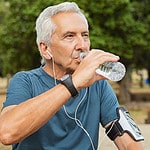Introduction
Exercise is essential for physical well-being. But, it can be painful and lead to injuries. Especially for those with knee issues. Wearing the right shoes makes exercise safer and can help relieve knee pain. This article will explain why proper footwear is important for knee pain relief when working out.
Overview of knee pain
Knee pain is frequent, especially for those active for long periods. Causes include inflammation, trauma, and medical conditions like osteoarthritis or rheumatoid arthritis. Exercise is a good solution, yet one must get the right shoes for support and to not have pain.
This guide will give an idea of the conditions that cause knee pain and the details of getting the best shoes to help with exercise.
Causes of knee pain
Pain in the knees is a common problem among those who workout. It can range from mild to severe or even disabling. Usually, proper footwear and cushioning help reduce or remove the knee pain related to exercise.
Overuse, muscle imbalance, poor form and technique, loss of flexibility and weak hip flexors and gluteal muscles can cause knee pain. Additionally, rolling your feet inwards during running can cause a rotation on the lower joint structures in the knee, leading to discomfort. Poorly fitting shoes, which don’t give enough support or stability for your foot type and gait style, can also be a factor in knee pain.
The Role of Proper Footwear
The correct shoes can be a major help in relieving knee ache when doing exercise. The right size and cushioning of the shoes can take the impact of running and jumping. This lowers strain on the joints.
This piece will talk about the advantages of proper footwear for knee pain relief while exercising.
Types of shoes for knee pain
Knee pain can be relieved with the right footwear when you exercise. Different shoes provide various levels of protection and variety. Here are common types of shoes to ease knee pain when being active:
- Running Shoes: Flexible, cushioning, and stable. Perfect for impact-heavy activities like running. Make sure they fit properly and provide arch support.
- Athletic Shoes: For sports like basketball or tennis. Usually heavier than running shoes. Provide more lateral stability when turning suddenly. Often have flat soles, not ideal for shock absorption.
- Cross Trainers: Combines features from running and athletic shoes. Offers flexibility and lateral stability. Best for activities with alternating periods of cardio and agility drills.
To get the most protection, select footwear specific to your exercise. Ask an orthopedist for advice before beginning a new exercise regime.
Benefits of proper footwear
Selecting good exercise shoes is important. It can support your feet, legs, and lower body. It can also protect them from harm.
Benefits of good footwear:
- Alignment: Good shoes can keep your spine, hips, and knees in the right place. It reduces strain from incorrect shoes.
- Cushioning: Cushioning helps stop injuries from impact. It provides comfort during workouts.
- Support: Shoes should fit properly. This allows for control and support when exercising.
- Traction: Good traction gives a firm grip on surfaces. It helps with balance during exercises.
Having the right shoes is important for safety and to prevent injuries. A good shoe will provide cushioning, support, and traction. This allows you to focus on becoming stronger without worrying.
How to Choose the Right Shoes
Choosing the right shoes for exercise can greatly reduce knee pain. Figuring out the type of shoes to buy and their features can help alleviate the stress of exercising with knee pain. Let’s take a look at the different types of shoes available and how they can help lessen the pain:
- Running shoes
- Cross-training shoes
- Walking shoes
- Court shoes
- Trail running shoes
Fit and cushioning
Fit and cushioning are both key for healthier knees. Shoes that fit properly, without any pinching or pressure points, aid in preventing orthopedic devices. When selecting a pair, be sure they’re wide and deep in the toe box, and consider your foot shape.
Cushioning is also important to reduce shock during activities such as walking, running, or standing. Many shoes have specialized cushioning systems. Look up comfort technologies and cushioning materials that provide extra padding. Also look for shoes with good motion control design; this helps limit rolling inward/outward when you walk.
Support and stability
Choosing the correct shoes is vital to protecting and supporting your feet and lower legs. When looking for an exercise shoe, make sure it has good arch support, ankle stabilization, and cushioning. Features such as air-filled heels and cushioning inserts are also great.
If you experience knee pain during activities, look for a shoe specifically designed for stability and cushioning. Motion control designs can give extra stability on uneven terrain or during sports like tennis or basketball.
For extreme terrain running (trail or mountain running), search for trail shoes with thicker rubber soles, midsole support, and lugs on the bottom of the outsoles for better footing.
Lastly, replace your trainers every 300-500 miles or every 6 months, regardless of usage. Cushioning breaks down over time, which results in less protection from impact while exercising.
Conclusion
To wrap up, the right shoes can be a key part of relieving knee pain while exercising. To get the best support for your knees and reduce the risk of pain and injury, you must take the right steps to get the right shoes. It is essential to get shoes that are suited to the activity you are taking part in.
So, if you’re serious about reducing knee pain while exercising, it is important to:
- Spend time researching the best footwear for you.
- Pay close attention to which ones you choose.
Summary of the importance of proper footwear for knee pain relief during exercise
Choosing the right shoes for exercise is essential. It helps reduce stress on knees and prevents injuries. It also boosts performance. However, it depends on the person’s foot shape, activity level, and goals. When selecting shoes, consider these: support, cushioning, breathability, and stability.
Support is crucial. It prevents feet from getting hurt while doing physical activities. It keeps them in alignment. The best shoe has a solid midsole/outsole and structural features to control pronation and supination.
Cushioning absorbs shock from running and jumping. Too much cushioning leads to energy losses.
Breathability helps regulate temperature. It also brings in airflow and reduces perspiration, which reduces odor and friction.
A good sole gives traction and shock absorption. It should be flexible for movement during exercise, for maximum power and efficiency.
Proper footwear supports fitness and keeps you healthy. It also prevents knee pain when doing side-to-side movements such as basketball and tennis. Taking into account all the factors mentioned will help avoid knee pain from tight muscles due to an ill-fitted pair of shoes when doing physical activities in gyms and sports fields.
Frequently Asked Questions
Q1: What type of shoes should I wear for knee pain relief?
A1: It is important to wear supportive shoes designed for the activity you are engaging in. For example, if you are running, you should wear running shoes with the appropriate cushioning for your feet and arch type. Additionally, you should ensure the shoes fit properly, with no extra room in the toes.
Q2: How do I know if my shoes are providing enough support?
A2: You should feel comfortable and supported when wearing your shoes. Additionally, if you are experiencing discomfort or pain, you should check the fit of your shoes to make sure they are not too tight or too loose. If the fit is not right, you may need to try a different style or size.
Q3: Are there any other tips for preventing knee pain while exercising?
A3: Yes, besides wearing the proper footwear, you should also focus on proper form, warm up and stretch before and after exercising, and rest when needed. Additionally, you should consider using a foam roller or other massage tool to help reduce any tightness, and use heat or ice therapy to reduce pain.





